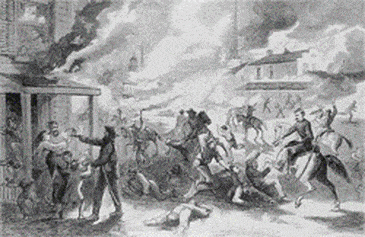The Pottawatomie Massacre was in response to the sacking of Lawrence, Kansas, by pro-slavery forces. John Brown and some followers attacked and killed five pro-slavery settlers in front of their wives and children. This is one of the many incidents that became known as Bleeding Kansas.

Pottawatomie Massacre: John Brown and Attack
After the sacking of Lawrence, many abolitionists were infuriated and became proactive.
John Brown was especially affected by the sacking.
Brown was outraged by both the violence of pro-slavery forces and by what he saw as a weak and cowardly response by the antislavery partisans and the Free State settlers, whom he described as cowards or worse
A Free State company under John Brown Jr. set out towards Lawrence. Their assistance in Lawrence was not needed, so they returned home.
On May 23, Sr. selected a party to go with him on a private expedition. Captain John Brown, Jr. objected to their leaving his company, but seeing that his father was obdurate, acquiesced, telling him to "do nothing rash."
The company consisted of John Brown, four of his sons, Frederick, Owen, Salmon, and Oliver, Thomas Weiner, and James Townsley (who claimed he was forced by Brown to participate in the incident), whom John had induced to carry the party in his wagon to their proposed field of operations.
They encamped that night between two deep ravines on the edge of the timber, some distance to the right of the main traveled road. There, they remained unobserved until the following evening of May 24.
Sometime after dark, the party left their place of hiding and proceeded on their "secret expedition." Late in the evening, they called the house of James P. Doyle and ordered him and his two adult sons, William and Drury, to go with them as prisoners.
The three men were escorted by their captors out into the darkness, where Owen Brown and one of his brothers killed them with broadswords. John Brown, Sr. did not participate in the stabbing but fired a shot into the head of the fallen James Doyle to ensure he was dead.
Brown and his band then went to the house of Allen Wilkinson and ordered him out. He was slashed and stabbed to death by Henry Thompson and Theodore Winer, possibly with help from Brown's sons.
From there, they crossed the Pottawatomie and, sometime after midnight, forced their way into the cabin of James Harris at swordpoint.
Harris had three house guests: John S. Wightman, Jerome Glanville, and William Sherman, the brother of Henry Sherman ("Dutch Henry"), a militant pro-slavery activist.
Glanville and Harris were taken outside for interrogation and asked whether they had threatened Free State settlers, aided Border Ruffians from Missouri, or participated in the sack of Lawrence.
Satisfied with their answers, Brown's men let Glanville and Harris return to the cabin. William Sherman was led to the edge of the creek and hacked to death with the swords by Winer, Thompson, and Brown's sons.
Having learned at Harris's cabin that "Dutch Henry," their main target in the expedition, was away from home on the prairie, they ended the expedition and returned to the ravine where they had previously encamped. They rejoined the Osawatomie company on the night of May 25.
In the two years prior to the massacre, there had been eight killings in Kansas Territory attributable to slavery politics, and none in the vicinity of the massacre. Brown murdered five in a single night, and the massacre was the match to the powder keg that precipitated the bloodiest period in "Bleeding Kansas" history, a three-month period of retaliatory raids and battles in which 29 people died.
Online Resources and Related Pages
- Wikipedia - Massacre in Bleeding Kansas
- The History Junkie’s Guide to the Civil War
- The History Junkie’s Timeline of the Civil War
- The History Junkie’s Timeline of American History
- The History Junkie’s Guide to Colonial America
- The History Junkie’s Guide to the Revolutionary War
- Slavery during the American Revolution
- Return to The History Junkie's Homepage
